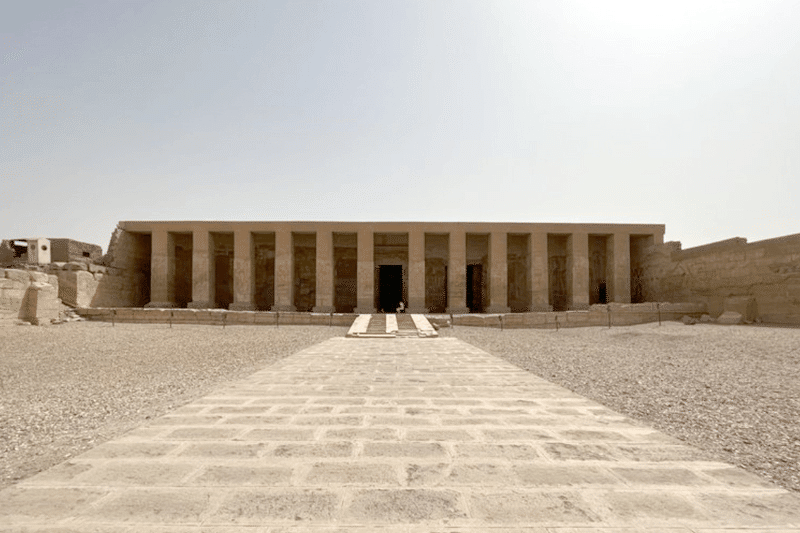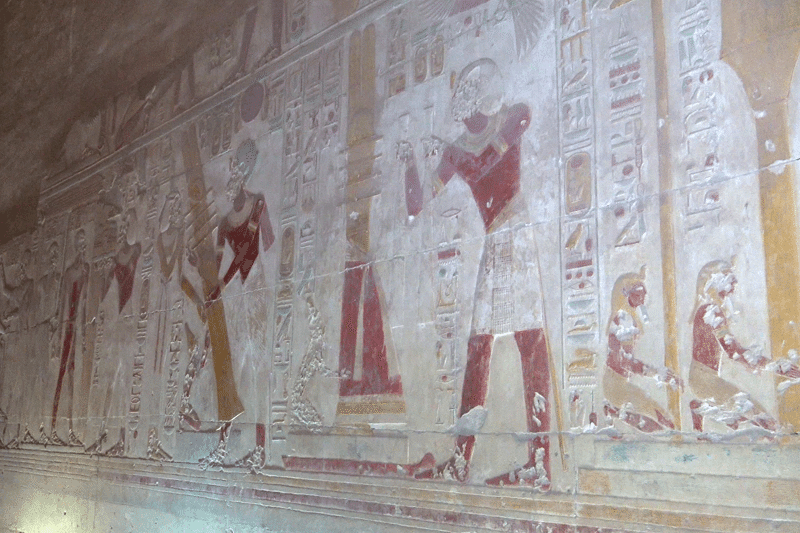
Mortuary Temple of Seti I 3D Scanning Project - WORLD SCAN PROJECT’s Challenge
The sacred site of Abydos considered the burial place of Osiris, the god of the underworld, was the center of worship of Osiris. It is an area of immense archaeological value, containing the tomb of Narmer, the first ruler of Egypt, the temple of Ramesses II, known as the great builder, and the Osireion, an empty tomb dedicated to Osiris.
World Scan Project (W.S.P) conducted an investigation of the Mortuary Temple of Seti I in Abydos, a site that retains a strong atmosphere of ancient Egypt.

The Unique Structure of the Mortuary Temple of Seti I
Seti I, a pharaoh of the 19th Dynasty, brought prosperity to Egypt through numerous military victories. His royal tomb in the Valley of the Kings is lavishly decorated with magnificent reliefs and murals celebrating his greatness.
The mortuary temple at Abydos is also filled with beautiful decoration, but its most distinctive feature is the design of seven sanctuaries, each with its entrance. Traditionally, temples had only one entrance and one sanctuary, making the mortuary temple of Seti I an unprecedented and innovative structure.

This mortuary temple was primarily dedicated to Osiris, the god of death and resurrection. The seven sanctuaries were dedicated to six gods (Horus, Isis, Osiris, Amun-Ra, Ra-Horakhty, and Ptah) and the deified Seti I. However, many of these entrances are now blocked, possibly due to renovations attempted by his son, Ramesses II.

The Sanctuary of Osiris
The mortuary temple of Seti I is remarkably well preserved, and its inner sanctuary, dedicated to Osiris, contains numerous reliefs painted in rich colors. In particular, the ornaments of Seti I and the goddess Isis are exquisitely detailed, capturing their smooth textures and reflecting the influence of the soft and realistic Amarna style.

In addition, the sanctuary contains depictions of rituals dedicated to Osiris and the spells required for these ceremonies. Near the area where Seti I touches the door to the shrine of Osiris, there is a spell for opening the door that reads, "The doors of the two heavens are opened, and the doors of the two earths are unlocked. And Osiris comes out of his shrine." In scenes of worship to Osiris, inscriptions such as "Offer Ma'at (truth) to the Lord, and present offerings to Osiris, the Creator" can be found. Additionally, entering the sanctuary where Osiris and his wife, the goddess Isis, awaited required specific spells, with each ceremony necessitating the appropriate incantation.


The sanctuary of Osiris has a different structure compared to the sanctuaries of other gods built in the mortuary temple of Seti I, being the only one with a space constructed at the back of the sanctuary.
This room, known as the "Osiris Complex", is decorated with wall reliefs depicting the "Raising of the Djed Pillar" ceremony. The Djed Pillar, a symbol of stability in ancient Egypt and considered the backbone of Osiris, signifies the acquisition of the power of rebirth and resurrection when raised. The ancient Egyptians believed that with the rebirth of Osiris, the king and the people could also achieve resurrection after death. Therefore, they left reliefs of the "Raising of the Djed Pillar" ceremony to eternally perpetuate the ritual of Osiris' rebirth.

Abydos King List
The King List, which records the names of past kings, contains 76 names, including Menes (Narmer), Sneferu, Khufu, and Djedefra. It is a valuable resource for studying the history and lineage of ancient Egyptian rulers. However, names such as Akhenaten, who converted from polytheism to monotheism, his son Tutankhamun, and the female pharaoh Hatshepsut are not listed, suggesting that Seti I did not consider them legitimate successors to the throne.


Making the world, the future, and curiosity closer
While the Temple of Seti I stands quietly in the sacred site of Abydos, its interior is decorated with colorful murals and reliefs that captivate visitors. However, only a small part of the temple remains intact, and it continues to weather even now.
To address this, the World Scan Project (W.S.P) conducts investigations using high-precision 3D scanning technology to preserve and publicly share these globally significant ruins. By meticulously recreating the scanned data in VR and the metaverse, researchers and the general public worldwide can observe the ruins as if they were there in person. This not only sheds light on many unresolved mysteries but also raises awareness about preservation. If you are interested in our activities, please follow and support the World Scan Project.


Please also check out this video about the Mortuary Temple of Seti I.
この記事が気に入ったらサポートをしてみませんか?
